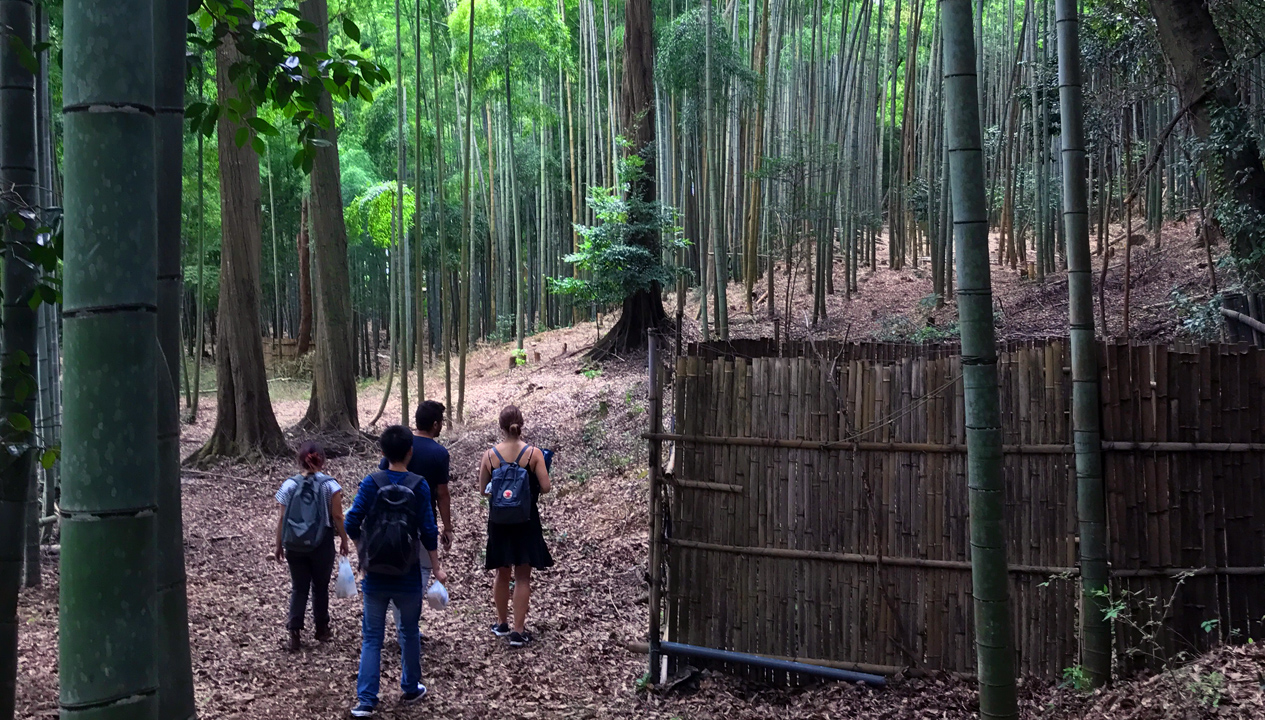On the 2nd full day of cultural immersion in Kyoto, we started with a round of Zen Meditation at Shorinji Temple. Many of us had never meditated before, and certainly not under the watchful eye of a Buddhist Monk, with his bamboo “Kaisaku” – a stick used during meditation to remedy sleepiness or lack of concentration!
Following a successful meditation, we lunched with the Monk and ate traditional Shojin Ryori cuisine, which is entirely plant-based (and extremely delicious) – perfect for the one vegan on our trip, Landi! We then walked to the Tofukuji Temple, one of Kyoto’s oldest and most famous temples, for some visual inspiration. Its Sanmon Gate is not only a National Treasure, it is the oldest Zen main gate in Japan. Its landscaping is exquisite, with incredibly lush plants and soothing rock gardens.
After a quick stop (and a tiny bit of shopping) at Kyoto Seika University’s student store, Kara-S at Cocon Karasuma, we pushed on for a visit to Sugimoto House, a traditional Kyomachiya-style townhouse right in the heart of downtown Kyoto. Born and raised in Sugimoto House, Ms. Setsuko Sugimoto is now the general director of the Foundation Naraya Sugimoto Residence, a national public interest corporation, to preserve the history of this building. Built in 1793, the townhouse is a living example of Kyoto’s past, and it embodies the mindset of Kyoto residents, to live side-by-side with nature. (Each room cooperates with nature, either by opening up into a beautiful garden or overlooking a pathway of individual stones.) The rooms flow from one to the next, each serving a particular purpose. The main greeting room is used for welcoming guests, and the adjacent alter changes frequently to represent a celebratory event or change in season. Another room contains an even larger altar, when family members offer gifts to their ancestors. The staircase to the upstairs is hidden, so as not to boast the amenities of the house. The kitchen is massive, one of the most impressive rooms in the house. Our students were challenged to help Ms. Sugimoto brainstorm some ways to engage more Kyoto residents and tourists with the Sugimoto House to help increase funds and awareness around the historic preservation of the building. Stay tuned…!
Our final stop of the day was the International Manga Museum – a major bucket-list item for many of our anime-loving students! The museum was founded as a joint project of Kyoto City and Kyoto Seika University to collect, preserve, and exhibit manga materials, and conduct research into manga culture. Manga materials preserved in the museum’s collection consist of approximately 300,000 items (as of 2016); including caricature woodblock prints of the Edo period, magazines of the Meiji, Taisho and early Showa period; as well as books ranging from post-war rental books to modern publications from abroad.
In a short lecture, we were provided some examples of “real-world” Manga – or graphics used to communicate information around difficult subjects. (Think sexual harassment, medical issues, etc.) Following the lecture, we had a quick tour of the museum to view the history and future of Manga and to view the massive collection. Unfortunately, the day was getting late, so our students didn’t have time to leisurely read in the courtyard! (Many of them returned on the weekend to spend hours there…and maybe have a caricature done by a living manga artist!)
Keep up with the Kyoto CULTURE // CRAFT team on the dedicated project page —> designmattersatartcenter.org/proj/study-away-kyoto-culture-craft/

